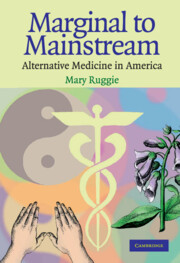Book contents
- Frontmatter
- Contents
- List of Tables
- List of Acronyms
- Preface
- 1 Introducing CAM … and the Many Questions It Raises
- 2 Understanding CAM: The Problem of Knowledge and the Power of Words
- 3 The Growth of CAM: Patterns of Use and Meaning
- 4 Physicians: Learning New Ways
- 5 Medical Research: Science and Interpretation
- 6 Investigating CAM: What Works?
- 7 The Road Ahead: Accommodation or Integration?
- Bibliography
- Index
1 - Introducing CAM … and the Many Questions It Raises
Published online by Cambridge University Press: 05 June 2012
- Frontmatter
- Contents
- List of Tables
- List of Acronyms
- Preface
- 1 Introducing CAM … and the Many Questions It Raises
- 2 Understanding CAM: The Problem of Knowledge and the Power of Words
- 3 The Growth of CAM: Patterns of Use and Meaning
- 4 Physicians: Learning New Ways
- 5 Medical Research: Science and Interpretation
- 6 Investigating CAM: What Works?
- 7 The Road Ahead: Accommodation or Integration?
- Bibliography
- Index
Summary
In 1971, New York Times reporter James Reston was stricken with acute appendicitis while in China to cover the Secretary of State's visit. He had surgery in a Beijing hospital. His article, describing how his postoperative pain was relieved by acupuncture, stimulated interest in the United States. Today Americans make more than 5 million visits per year to acupuncturists (Eisenberg et al. 1998).
In 1975, Herbert Benson, a cardiologist at Harvard Medical School, published a pathbreaking book, The Relaxation Response, which showed how cardiac disease could be slowed, even reversed, through meditation. New knowledge about nutrition also began to help heart patients. Dietary guidelines, revised in the 1980s, warned against eating red meat and other animal fats and encouraged heart patients to increase their intake of fiber.
In the early 1990s, cancer clinics across the United States introduced patients to stress reduction, visualization, music therapy, and aromatherapy, to name a few novel treatments, to help them through the traumas of chemotherapy and survive the trials of their illnesses. Palliative care clinics also expanded and are now a gratifying source of solace for dying patients and their families.
In the late 1990s, reports that sham surgery – that is, placebo – worked as well as real surgery for patients with Parkinson's disease and for people with arthritis of the knee stunned the medical community and put some surgeons in a precarious position.
Information
- Type
- Chapter
- Information
- Marginal to MainstreamAlternative Medicine in America, pp. 1 - 18Publisher: Cambridge University PressPrint publication year: 2004
